Fostering trust in information starts with establishing project scope, assessing the current situation, and determining the most appropriate vision
As digital transformation spreads throughout the enterprise, the need for effective Data Governance is gaining importance, benefiting every task or process where reliable data is indispensable. Note I did not say “can” benefit or “may” benefit.
Dramatic as it is, digital transformation is only one of the drivers of the need for Data Governance. Many other changes are sweeping through today’s successful enterprises. The ways that products are developed, marketed, and serviced are rapidly and fundamentally changing. So are the ways in which the countless tasks of the enterprise get done—as well as who is doing those tasks and the tools they use.
This quick look is a high-level overview of the urgent need for Data Governance (DG). Without effective DG, the information underlying business and operations decision-making will not be fully reliable, at best. Neither will the data fed into the engineering models and analyses. At worst, this iffy data can lead to decisions that jeopardize new-product development and may even undermine the enterprise’s future.
CIMdata defines Data Governance as “the organization and implementation of policies, procedure, structure, roles, and responsibilities that outline and enforce rules of engagement, decision rights, and accountabilities for the effective management of information assets.”
In short, Data Governance is a board of directors for information. This means DG is a discipline to ensure that data can be trusted—that data problems will be uncovered before an analysis or decision goes badly wrong.
DG issues are best addressed within a Product Lifecycle Management (PLM) environment and/or using departmental and business unit solutions that are part of an enterprise’s PLM environment. Even this needs caution: PLM itself is evolving from a product-specific focus to innovation overall.
As in establishing any internal improvements, a DG project team must look carefully into the enterprise’s existing arrangements for managing its data:
- Enterprise information management (EIM), with its formal and informal fixes for internal barriers to information sharing.
- Enterprise architecture (EA) is the top-down picture of the systems, tools, and structures that create and process the organization’s information.
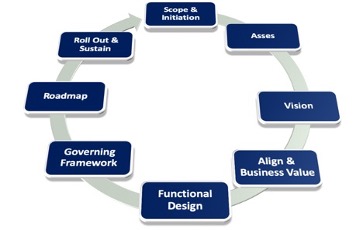
DATA GOVERNANCE: 8 distinct phases showing the iterative process for starting and sustaining DG implementation. Source: Data Governance:How to Design, Deploy and Sustain an Effective Data Governance Program (2012) by John Ladley. The book is available on Amazon and Barnes & Noble among other sites.
The complexities of EIM and EA demand that DG implementations take a careful and well-thought-out, one-phase-at-a-time approach. The first three phases are addressed here—Scope & Initiation, Assess, and Vision.
In a high-level overview, Scope & Initiation means identifying business units and organizations subject to Data Governance, proposing the scope and an initial plan to define and deploy, developing a rollout team structure, and then gaining approvals of both scope and constraints.
Key activities in Scope & Initiation include determining to-be states, developing the organizational aspects (the operating framework and organizational chart with roles and responsibilities); initial strategies, policies, processes, monitoring tools, and metrics; data investigation priorities; and preliminary approaches to technology and architecture.
In its overview, Assess addresses the maturity of existing information, capacity for change management, and collaborative readiness.
Activities in the Assess phase include reviewing the maturity of data and processes in the EIM and EA environments; reviewing the enterprise’s business models and operating models; clarifying proposed Data Governance processes, metrics; and best practices, including the investigation and monitoring tools and the as-is state of the proposed new technology and architecture.
The overview of the Vision phase includes the definition of DG for your organization with preliminary requirements and representations of DG in the near future. Essential Vision-phase activities are to determine the To-Be state, define the change management process, and educate the stakeholders about your Data Governance approach.
This exacting approach is made inevitable by sweeping changes in the industrial and tech worlds:
- Democratization, as in staffers with minimal expertise using modeling, analytical, and optimization tools.
- Socialization is the meshing of collaboration and communication that brings a diversity of workers, skill sets, and viewpoints into each project—tied together with messaging apps, which are evolving rapidly.
- Real-time connectivity with its vast inflows and accumulations of data; these inflows are automated and rarely verified until reuse.
- Workforce generation gaps as the so-called Generation Z is hired in by the Millennials (who replaced the now retiring Baby Boomers).
Together, these developments are turning many long-established processes and tools obsolete more quickly than ever, undermining enterprise goals such as continuous improvement. As the useful lifespans of many trusted solutions are shortened, they become part of the problem and pose additional threats to competitiveness amid the ever-present worries of globalization, budget pressures, competition, growing product complexity, and disruption of product plans.
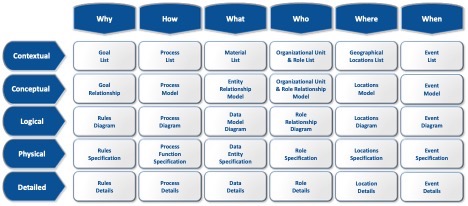
DATA GOVERNANCE COMPONENTS: This Zachman schematic lays out 30 Data Governance components in the ontology of an Enterprise Architecture. The components’ five-level hierarchy is at the left; the way each component is overseen is in the columns. Source: DAMA-DMBOK Data Management Body of Knowledge, 2nd Edition, 2017. Available from DAMA International.
PLM is invaluable because to be effective Data Governance oversight must have a broad span and cover many different forms of data, both structured and unstructured that are:
- Fed into models and analyses, quality assurance, risk assessment, field service, warranty management, and responses to regulators’ demands.
- Built into digital twins and digital threads.
- Migrating out of file formats and into data records, which is regularly restructured for new contexts and needs.
- At risk due to connections with off-premises computing (“the Cloud”), blockchains, and the Internet of Things (IoT).
- Created with or used by additive manufacturing / 3D printing, tools, generative approaches analysis and optimization, artificial intelligence, machine learning, and video, especially virtual and augmented reality.
- Exchanged with customers, suppliers, and business partners.
- Impacted by the convergence of end-to-end lifecycle concepts and practices, systems engineering, and configuration management.
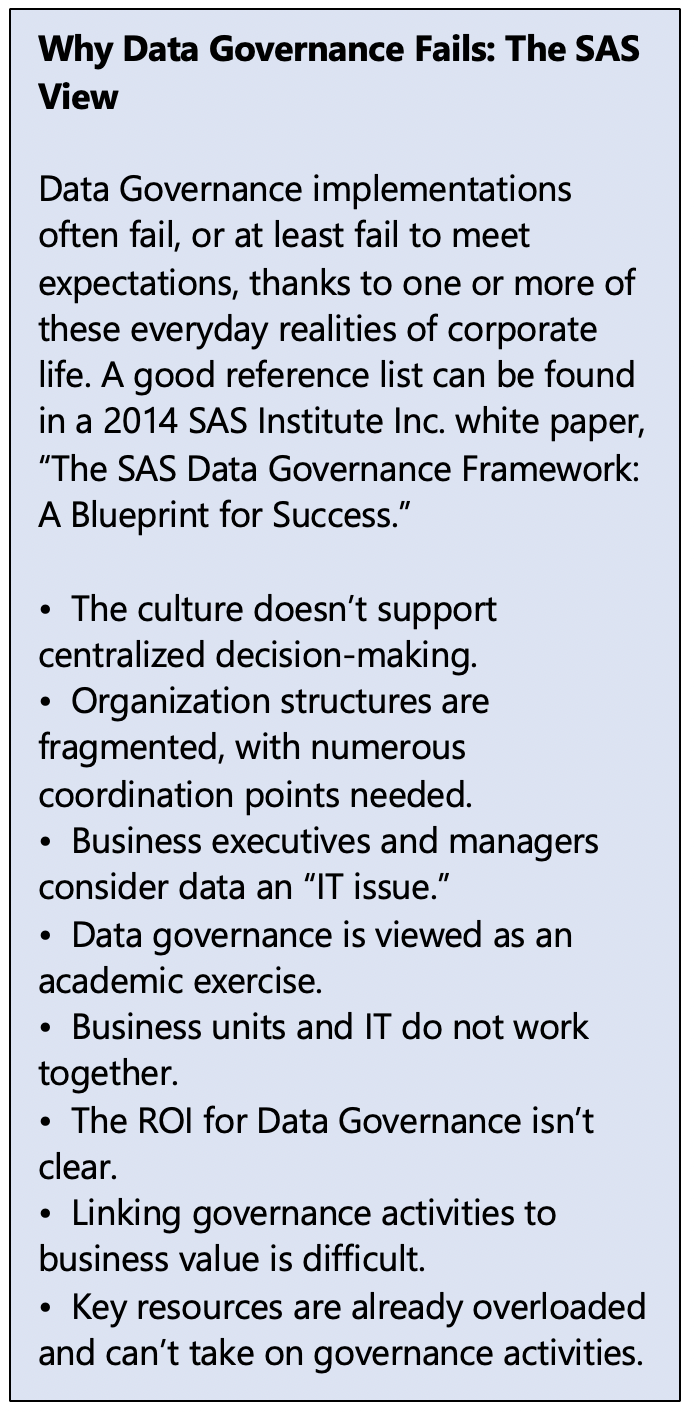 For all these challenges, PLM-enabled Data Governance safeguards the value of the enterprise’s information despite decades of continuous use and reuse, constant change, rapid accumulation, fragmentation, and conflicting claims of ownership. DG also protects against corruption that can occur when data is freed from outdated and unconnected tools.
For all these challenges, PLM-enabled Data Governance safeguards the value of the enterprise’s information despite decades of continuous use and reuse, constant change, rapid accumulation, fragmentation, and conflicting claims of ownership. DG also protects against corruption that can occur when data is freed from outdated and unconnected tools.
The CIMdata definition also is a caveat. Data governance should not be confused with data management. For better or worse, every unit in the organization manages its own data and links to other departments and functions. The issue for Data Governance is verifying that these units’ approaches are valid, i.e., that they are not mismanaging their data or misusing their links.
All too often, the importance of these links goes unrecognized or unappreciated. This helps explain why many DG initiatives exist in name only. See sidebar, “Why Data Governance Fails: The SAS View.”
As if all this were not enough to justify DG, bear in mind that the pace of change is accelerating. Delaying a start on DG means that the challenges keep piling up. This is why I pointed out the importance of understanding EIM and EA.
CIMdata has reached a consensus that the best way to establish Data Governance is known as the Modified Zachman Framework.[1] It provides detailed approaches to establishing a fundamental enterprise architecture that will ensure DG is timely, measurable, compliant, repeatable, and consistent.
A strength of the Modified Zachman approach is its fundamental, two-dimensional schematic (“ontology”) of key DG components in an Enterprise Architecture. To make complex structures and procedures easier to understand and communicate, the components are listed horizontally as a hierarchy—Detailed, Physical, Logistical, Conceptual, and Contextual. The ways they are to be implemented and managed are presented in six vertical columns labeled Why, How, What, Who, Where, and When. No two implementations and enterprises have the same DG needs; some require more than the 6x5 array of elements shown here, while others need fewer.
Other widely used DG approaches are Mike2.0 Framework, the Data Governance Institute Framework, the IBM Data Governance Council Framework and Maturity Model, Quality Function Deployment (QFD), and Modified QFD, plus approaches tailored to specific industries. “Modified” frameworks have been scaled down. Frameworks differ, so choosing and following what is right for your enterprise is important.
A big part of any framework-based implementation’s appeal is that objectives and actions to be taken (“activities”) are spelled out for each phase, as shown in the images below.
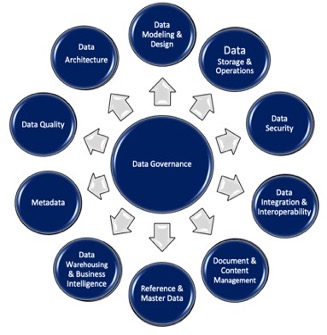
DATA GOVERNANCE: 10 areas of information focus during implementation. Source: DAMA-DMBOK Data Management Body of Knowledge.
Expect difficulties. The process a group goes through in solving a difficult problem is neither smooth nor sequential; this is as true in Data Governance as in any similar effort. Decision-making is often initially characterized by confusion and misunderstanding—sometimes called a Groan Zone. Most people find it hard to tolerate ambiguity and conflict when there is no shared frame of reference. Yet most groups’ significant breakthroughs are often reached only after a period of struggle.[2]
Two further caveats:
- Avoid “big-bang” starts. Rollouts should be incremental, as the DAMA-DMBOK Data Management Body of Knowledge stresses. Data Governance is commonly implemented in a sizable project, such as over the enterprise’s master data management (MDM). “Rarely is DG deployed enterprise-wide as a first effort,” DAMA points out.
- Data Governance is often too big for a holistic implementation. Experts suggest breaking it down into its components so it can be more easily prioritized, aligned with enterprise goals and economic impacts, and scaled up.
Data Governance Benefits
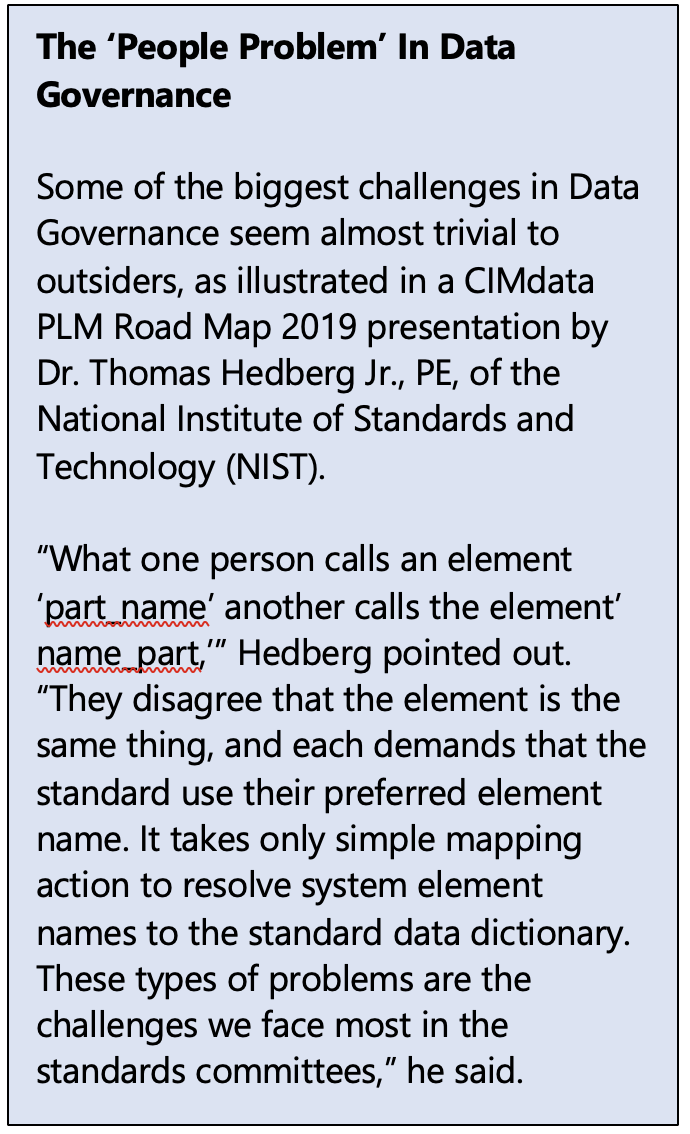 When Data Governance is fully implemented, a long list of benefits accrues in the trustworthiness of the enterprise’s information and to the enterprise itself.
When Data Governance is fully implemented, a long list of benefits accrues in the trustworthiness of the enterprise’s information and to the enterprise itself.
In the realm of data, effectively governed information will be sustainable, with processes in place to manage demands for change. Data Governance will be embedded in software development, in the use of data for analytics, in keeping track of master data (lists, repositories, files detailing business basics), metadata (data about data), and supporting “smart” connectivity that is increasingly demanded. Improvements will be measurable from baselines.
These improvements will include reducing risks from decisions based on “bad” data, enhanced risk management enterprise-wide, improved data security, and better assurances of privacy.
Data Governance will also bring with it visible process improvements in regulatory compliance, data quality, and metadata management. Information-development projects’ effectiveness will increase, and IT supplier management will improve.
More broadly, leadership and sound data strategies will be assured in the enterprise realm. They will be principle-based, residing in a multi-layered, business-driven framework, anchored in shared responsibility, and enabled with PLM.
Effective Data Governance can be expected to exercise authority and control over the enterprise’s data assets in any and all forms. This authority includes planning, monitoring, stewardship, enforcement, oversight, and containment. Appropriate policies, procedures, structures, and best practices will be clarified and made known to all.
How decisions about data are made will go under examination, as will the behavior of people and processes as they work with the enterprise’s data assets. The value of consistency and classification will quickly be apparent in both data representations and data content. At the same time, the growth of DG and its frameworks will be accommodated in a valuable new means of organization-wide communication.
However, none of this will happen if Data Governance does not get off to a solid start with scope & initiation, assessment, and vision.



